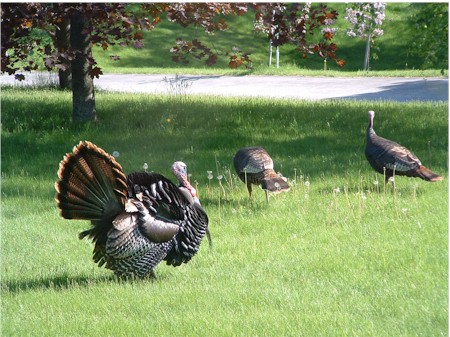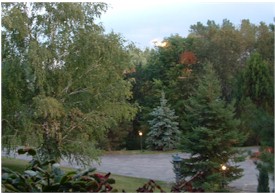
The Idea: Whether you live in the country or the city there are opportunities to renaturalize your community, and in so doing transform and enrich it ecologically, physically and psychologically. We had the great pleasure this past weekend of a visit and tour by wildlife biologist Natalie Helferty. The purpose of her visit, which I negotiated (thanks to Natalie for volunteering her time, and to Richard Procter of the local Green Party for helping me find her), was to acquaint us with the natural ecosystem in which we live, especially the local wetlands. We are extremely fortunate, as the aerial photo above shows, to live in an area where nature and wilderness coexist somewhat harmoniously with human habitation and human activity, an area on the Oak Ridges Moraine peppered with kettle ponds scoured out by ancient glaciers. It is home to a wide variety of wildlife: beavers and muskrats, woodchucks and skunks, wild turkeys, whitetailed deer, grey wolves, great blue herons, red foxes, spring peepers, and geese ‘superfamilies‘ with their dozen or more adorable and obedient goslings. But while we were mostly focused on mammals and birds at the top of the food chain, Natalie had us focus at the bottom — at the plants that essentially create the ecosystem and sustain the rest of its life. Specifically, she told us which of the species of trees, shrubs, sedges, grasses, flowers and other flora were native to the Oak Ridges Moraine and which (an astonishing number) were not. She suggested the best thing we could do for all of the inhabitants of our lovely little community would be to renaturalize the plant life — to weed out some of the invasive species that keep the ecosystem out of kilter, and to seed and plant native species. This is difficult for the same reason all of the other significant changes we need to make in our world will be difficult — to get from here to there, things may have to get worse before they can get better. Short term pain for long term gain is not a very popular mantra in our modern civilization. Renaturalization can’t happen overnight — you need to prepare the ground for it, and let nature take its course slowly, going through some possibly shabby, messy-looking intermediate steps before the beautiful, natural, sustainable ecosystem can be fully restored. We have one neighbour who’s already started — no lawn, and only natural plant species planted. The largest business in our town, Husky Injection Molding, has won many awards for keeping the expansive grounds around its large plant planted only with native species, and those grounds are lovely — and sustainable. Most of the neighbours have stopped using pesticides and some now use only organic fertilizers, sparingly. Most lawns are only watered when re-seeding. But the idea of having no lawn is stressful to many, and the transition from uniform-cut lawn to natural vegetation will be much more so — and could invite some backlash from those concerned with ‘property values’. Natalie says the ‘English lawn’ originated with British aristocracy as a status symbol of nobility — for people who were so wealthy they could afford to have their land ‘do nothing’, and that ill-conceived vanity continues to this day. But what do you do if you live in a city, with concrete and steel everywhere and no place to start, or even imagine, renaturalization? Perhaps the best place to start is brownfield areas. Not only are they low-valued, they are the ugliest of our urban landscapes, and hence we might be more tolerant of the intermediate messiness as nature, with our newly-knowledgeable support, reclaims these lands as oases of true wilderness in the contemporary city desert. One step at a time. (More articles on renaturalization here, here, and here. But this is a very local project. Chances are you won’t get much idea online of what your area looked like, and what plants it contained, in its natural state. You’re going to have to do some real research. Photos are all from 2004 — the top one is from Google Maps, the goose picture is from Bernd Heinrich, and the rest are mine, taken in our neighbourhood.) |
Navigation
Collapsniks
Albert Bates (US)
Andrew Nikiforuk (CA)
Brutus (US)
Carolyn Baker (US)*
Catherine Ingram (US)
Chris Hedges (US)
Dahr Jamail (US)
Dean Spillane-Walker (US)*
Derrick Jensen (US)
Dougald & Paul (IE/SE)*
Erik Michaels (US)
Gail Tverberg (US)
Guy McPherson (US)
Honest Sorcerer
Janaia & Robin (US)*
Jem Bendell (UK)
Mari Werner
Michael Dowd (US)*
Nate Hagens (US)
Paul Heft (US)*
Post Carbon Inst. (US)
Resilience (US)
Richard Heinberg (US)
Robert Jensen (US)
Roy Scranton (US)
Sam Mitchell (US)
Tim Morgan (UK)
Tim Watkins (UK)
Umair Haque (UK)
William Rees (CA)
XrayMike (AU)
Radical Non-Duality
Tony Parsons
Jim Newman
Tim Cliss
Andreas Müller
Kenneth Madden
Emerson Lim
Nancy Neithercut
Rosemarijn Roes
Frank McCaughey
Clare Cherikoff
Ere Parek, Izzy Cloke, Zabi AmaniEssential Reading
Archive by Category
My Bio, Contact Info, Signature Posts
About the Author (2023)
My Circles
E-mail me
--- My Best 200 Posts, 2003-22 by category, from newest to oldest ---
Collapse Watch:
Hope — On the Balance of Probabilities
The Caste War for the Dregs
Recuperation, Accommodation, Resilience
How Do We Teach the Critical Skills
Collapse Not Apocalypse
Effective Activism
'Making Sense of the World' Reading List
Notes From the Rising Dark
What is Exponential Decay
Collapse: Slowly Then Suddenly
Slouching Towards Bethlehem
Making Sense of Who We Are
What Would Net-Zero Emissions Look Like?
Post Collapse with Michael Dowd (video)
Why Economic Collapse Will Precede Climate Collapse
Being Adaptable: A Reminder List
A Culture of Fear
What Will It Take?
A Future Without Us
Dean Walker Interview (video)
The Mushroom at the End of the World
What Would It Take To Live Sustainably?
The New Political Map (Poster)
Beyond Belief
Complexity and Collapse
Requiem for a Species
Civilization Disease
What a Desolated Earth Looks Like
If We Had a Better Story...
Giving Up on Environmentalism
The Hard Part is Finding People Who Care
Going Vegan
The Dark & Gathering Sameness of the World
The End of Philosophy
A Short History of Progress
The Boiling Frog
Our Culture / Ourselves:
A CoVid-19 Recap
What It Means to be Human
A Culture Built on Wrong Models
Understanding Conservatives
Our Unique Capacity for Hatred
Not Meant to Govern Each Other
The Humanist Trap
Credulous
Amazing What People Get Used To
My Reluctant Misanthropy
The Dawn of Everything
Species Shame
Why Misinformation Doesn't Work
The Lab-Leak Hypothesis
The Right to Die
CoVid-19: Go for Zero
Pollard's Laws
On Caste
The Process of Self-Organization
The Tragic Spread of Misinformation
A Better Way to Work
The Needs of the Moment
Ask Yourself This
What to Believe Now?
Rogue Primate
Conversation & Silence
The Language of Our Eyes
True Story
May I Ask a Question?
Cultural Acedia: When We Can No Longer Care
Useless Advice
Several Short Sentences About Learning
Why I Don't Want to Hear Your Story
A Harvest of Myths
The Qualities of a Great Story
The Trouble With Stories
A Model of Identity & Community
Not Ready to Do What's Needed
A Culture of Dependence
So What's Next
Ten Things to Do When You're Feeling Hopeless
No Use to the World Broken
Living in Another World
Does Language Restrict What We Can Think?
The Value of Conversation Manifesto Nobody Knows Anything
If I Only Had 37 Days
The Only Life We Know
A Long Way Down
No Noble Savages
Figments of Reality
Too Far Ahead
Learning From Nature
The Rogue Animal
How the World Really Works:
Making Sense of Scents
An Age of Wonder
The Truth About Ukraine
Navigating Complexity
The Supply Chain Problem
The Promise of Dialogue
Too Dumb to Take Care of Ourselves
Extinction Capitalism
Homeless
Republicans Slide Into Fascism
All the Things I Was Wrong About
Several Short Sentences About Sharks
How Change Happens
What's the Best Possible Outcome?
The Perpetual Growth Machine
We Make Zero
How Long We've Been Around (graphic)
If You Wanted to Sabotage the Elections
Collective Intelligence & Complexity
Ten Things I Wish I'd Learned Earlier
The Problem With Systems
Against Hope (Video)
The Admission of Necessary Ignorance
Several Short Sentences About Jellyfish
Loren Eiseley, in Verse
A Synopsis of 'Finding the Sweet Spot'
Learning from Indigenous Cultures
The Gift Economy
The Job of the Media
The Wal-Mart Dilemma
The Illusion of the Separate Self, and Free Will:
No Free Will, No Freedom
The Other Side of 'No Me'
This Body Takes Me For a Walk
The Only One Who Really Knew Me
No Free Will — Fightin' Words
The Paradox of the Self
A Radical Non-Duality FAQ
What We Think We Know
Bark Bark Bark Bark Bark Bark Bark
Healing From Ourselves
The Entanglement Hypothesis
Nothing Needs to Happen
Nothing to Say About This
What I Wanted to Believe
A Continuous Reassemblage of Meaning
No Choice But to Misbehave
What's Apparently Happening
A Different Kind of Animal
Happy Now?
This Creature
Did Early Humans Have Selves?
Nothing On Offer Here
Even Simpler and More Hopeless Than That
Glimpses
How Our Bodies Sense the World
Fragments
What Happens in Vagus
We Have No Choice
Never Comfortable in the Skin of Self
Letting Go of the Story of Me
All There Is, Is This
A Theory of No Mind
Creative Works:
Mindful Wanderings (Reflections) (Archive)
A Prayer to No One
Frogs' Hollow (Short Story)
We Do What We Do (Poem)
Negative Assertions (Poem)
Reminder (Short Story)
A Canadian Sorry (Satire)
Under No Illusions (Short Story)
The Ever-Stranger (Poem)
The Fortune Teller (Short Story)
Non-Duality Dude (Play)
Your Self: An Owner's Manual (Satire)
All the Things I Thought I Knew (Short Story)
On the Shoulders of Giants (Short Story)
Improv (Poem)
Calling the Cage Freedom (Short Story)
Rune (Poem)
Only This (Poem)
The Other Extinction (Short Story)
Invisible (Poem)
Disruption (Short Story)
A Thought-Less Experiment (Poem)
Speaking Grosbeak (Short Story)
The Only Way There (Short Story)
The Wild Man (Short Story)
Flywheel (Short Story)
The Opposite of Presence (Satire)
How to Make Love Last (Poem)
The Horses' Bodies (Poem)
Enough (Lament)
Distracted (Short Story)
Worse, Still (Poem)
Conjurer (Satire)
A Conversation (Short Story)
Farewell to Albion (Poem)
My Other Sites








